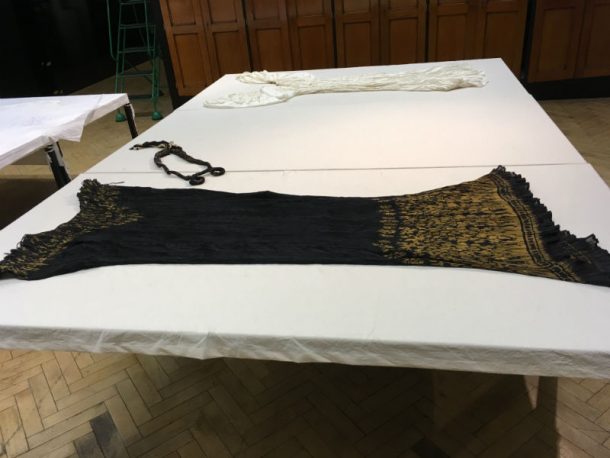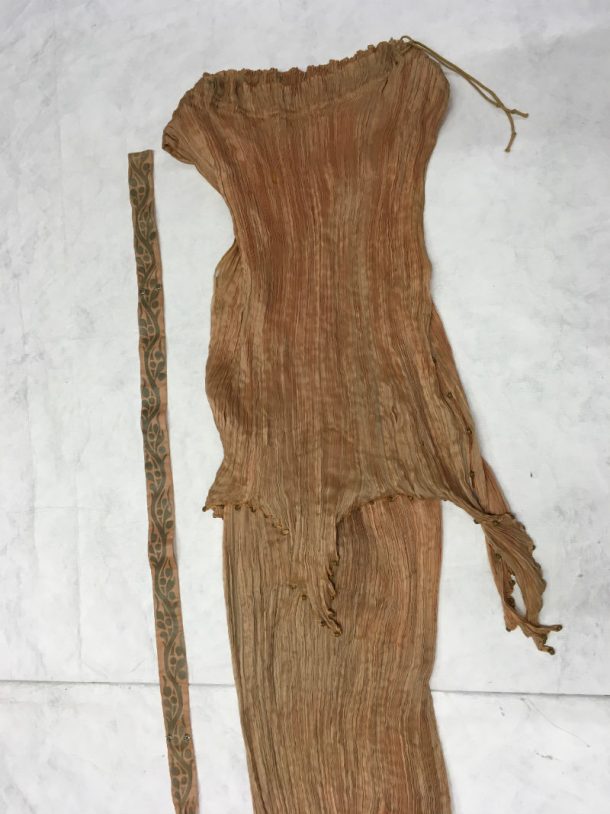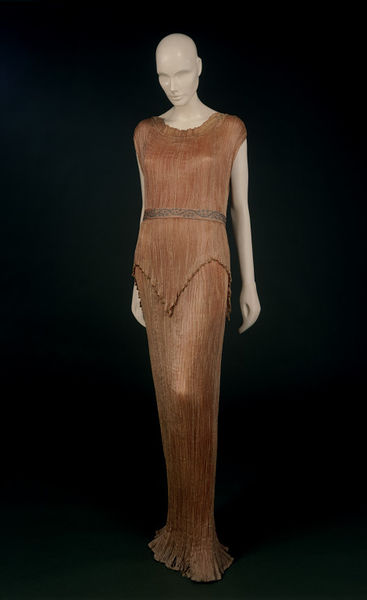There are nine ‘Delphos’ gowns in the V&A collection, all of which are currently in storage at the Clothworkers’ Centre. We have a range of cuts and colours, including apricot, white, and black with gold fleur-de-lis. These dresses are often requested for appointments, and I’m not surprised about this.

Many people see them as timelessly elegant. Although ‘Delphos’ were made during the first half of the twentieth century, it’s easy to imagine them bursting onto the scene today. This may be largely because they were modelled on chitons, garments worn in early Greek periods which have long exerted a strong influence over European and European-influenced design. More specifically, Mariano Fortuny, the Spanish fashion designer who thought up the ‘Delphos’ dress, was inspired by ‘The Charioteer of Delphi.’ This Early Classical Greek bronze statue represents a charioteer holding reins, wearing an Ionic chiton. Ionic chitons can be set apart from their simpler Doric equivalents by their sleeves.
Note added by the author on 27 October 2021: Henriette Nigrin is increasingly recognised as largely or wholly responsible for the creation of the ‘Delphos.’ For more on this, see the updated records for the ‘Delphos’ dresses in the V&A collection.
‘Delphos’ dresses may also be popular because they were revolutionary. First produced in 1907 in Italy, and in demand until around mid-century in places including Italy, Britain, and the United States, ‘Delphos’ gowns were a significant departure from the mainstream womenswear worn in the places where these dresses proved popular. These pleated silk gowns were unusually simple. Most are patternless and only decorated with a small number of functional glass beads (the weight of the beads helps ‘Delphos’ dresses to hang correctly, and they sometimes work as fastenings). And these flexible silk gowns were strikingly light and non-restrictive, especially compared to garments such as the narrow skirts that were in fashion in places including Britain in the years leading up to the First World War. Further, ‘Delphos’ did not tend to be worn with the highly structured women’s undergarments, such as corsets, commonly worn in the first part of the twentieth century. They tended to be sported with very little beneath. They were associated, therefore, with both functionality and comfort, and sensuality. Fortuny’s ‘Delphos’ gowns would have stood out in their day, and they can be seen to have blurred gender boundaries. They resembled much contemporary menswear in being relatively simple and physically liberating, and were inspired by a statue of a young man.
While ‘Delphos’ dresses were undeniably radical, it should be emphasised that they were part of a tradition of sartorial reform. Promoters of what was known in Britain as Rational dress advocated and often wore newly practical womenswear throughout the latter decades of the nineteenth century and at the start of the twentieth. These dress reformers, most of whom were British or North American, were particularly interested in bifurcated legwear, like the feminists who embraced Bloomers (full trousers gathered at the ankles named after the North American suffragist Amelia Bloomer) around 1850. Other women, and men, who took issue with mainstream European and European-influenced womenswear of the period favoured aesthetic dress, also known as artistic dress. Those who designed aesthetic womenswear were inspired by Pre-Raphaelite and aesthetic paintings which depicted women in flowing, historically-influenced dresses. Fortuny’s ‘Delphos’ dresses are very much connected to this latter movement in particular, which continued to flourish well into the twentieth century. It is no coincidence that the white ‘Delphos’ gown housed at Clothworkers’ belonged to the Elfrida Thoryncroft, whose parents Agatha and Hamo Thornycroft were member of the Healthy and Artistic Dress Union (founded in 1890). One of Agatha Thornycroft’s aesthetic dresses is in the V&A collection.
‘Delphos’ gowns are even more fluid than most aesthetic garments, and their unusual design makes them really interesting in terms of storage. Whereas most dresses at Clothworkers’ are either hung or kept flat in drawers, our ‘Delphos’ are stored twisted and then rolled into snail-like shapes. This prevents the pleats from being flattened out and guards against these garments losing their bounce. When brought out for Clothworkers’ appointments these gowns undergo striking transformations. They are transformed again when seen on a body or, in the case of museum-owned ‘Delphos,’ a mannequin.


If you’re interested in making an appointment to view textiles and fashion objects at the Clothworkers’ Centre, please email clothworkers@vam.ac.uk.
This post was edited by the author on 27 October 2021 as part of work on sensitive terminology and topics. Some additional edits were made at the same time to further improve the post.


